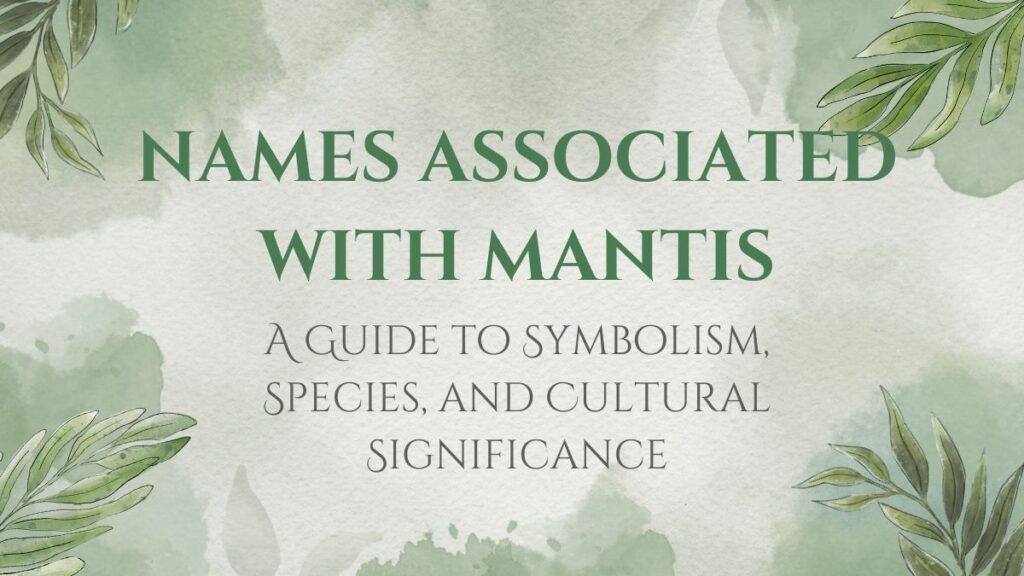Mantis insects have long captured the human imagination, with their striking appearance, predatory behavior, and symbolic connections in various cultures. The phrase “names associated with mantis” refers to not just the different species and subspecies of mantis but also the cultural, mythological, and symbolic meanings attached to these fascinating creatures. In this article, we will dive deep into the various names associated with mantis, examining their scientific, linguistic, and cultural significance across the world.
Understanding the Mantis: A Brief Overview
Before we delve into the names associated with mantis, it’s essential to understand the basic biology and significance of the mantis. Mantis refers to the order Mantodea, which encompasses over 2,400 species spread across about 15 families. These insects are most commonly recognized by their triangular heads, long thoraxes, and large, folded forelegs that resemble a prayer-like posture—hence the term “praying mantis.”
Types of Mantis and Their Names
There are numerous species of mantis, each with its own unique features. Below is a breakdown of some of the most well-known species, their scientific names, and other names they may be known by.
| Common Name | Scientific Name | Other Names | Region | Unique Features |
| Praying Mantis | Mantis religiosa | European Mantis, Common Mantis | Europe, Asia, North America | Famous for its “prayer-like” posture, often green or brown |
| Giant Asian Mantis | Hierodula membranacea | Chinese Mantis | Asia | Large size, aggressive nature |
| Orchid Mantis | Hymenopus coronatus | Walking Flower Mantis | Southeast Asia | Camouflaged to resemble orchids, prized for beauty |
| Carolina Mantis | Stagmomantis carolina | – | Southeastern U.S. | Known for its vibrant green color |
| Devil’s Flower Mantis | Idolomantis diabolica | – | Africa | Large and striking, often used in pet trade |
| African Mantis | Sphodromantis viridis | – | Africa | Beautiful green coloration, commonly seen in captivity |
Each of these mantis species has its distinct features and geographic distribution, with many also having popular or regional names that differ across cultures and areas.
Mantis Names in Popular Culture
Names associated with mantis aren’t limited to scientific classifications. Over the years, the mantis has featured prominently in literature, folklore, movies, and other forms of popular culture. These names often carry symbolic meanings or evoke certain characteristics that reflect the qualities of the insect.
Mythological and Cultural Names Associated with Mantis
The mantis holds symbolic importance across a variety of cultures, often representing patience, focus, and precision due to its hunting techniques and still posture. In certain African and Indigenous cultures, the mantis is viewed as a trickster or spiritual guide. Here are some cultural and mythological names associated with the mantis:
- The Mantis in African Mythology
- In Southern Africa, the mantis is known as the “Mantis God” or “The Trickster.” In these traditions, the mantis is often depicted as a wise and cunning figure who helps or hinders humans based on his moods and actions. This figure also teaches lessons about humility, cleverness, and survival.
- The Mantis in Native American Culture
- Some Native American tribes regard the mantis as a symbol of stillness, patience, and meditation. The stillness of the mantis when hunting is seen as a form of peaceful determination. It represents the ability to wait and act when the time is right.
- Mantis in Ancient Egypt
- In Ancient Egypt, the mantis was considered sacred, particularly because of its hunting skills. The Egyptians associated the mantis with the goddess of justice and wisdom, Ma’at, often symbolizing the balance of life and the importance of focus.
The Mantis in Modern Fiction
Mantis has become a popular character in modern fiction, appearing in comic books, video games, and films. Some notable fictional mantis representations include:
- Marvel Comics – Mantis
- In Marvel Comics, Mantis is a superhero who was a member of the Avengers. She was depicted as a skilled martial artist with the ability to communicate with plants and a strong connection to mystical powers. This fictional mantis character was inspired by the insect’s unique qualities.
- Guardians of the Galaxy (Marvel Cinematic Universe)
- The character “Mantis” in the Guardians of the Galaxy film series is portrayed as a gentle but powerful empath who can sense the emotions of others. The character is a nod to the insect’s characteristic stillness and patience.
Names Associated with Mantis in Different Languages
Different languages and cultures have their own distinct names for the mantis. These names may reflect the physical appearance of the insect, its predatory behavior, or its symbolic significance. Here are some examples of mantis names across various languages:
- Spanish: “Mantis religiosa” (Religious Mantis), referencing the insect’s prayer-like posture.
- French: “Mante religieuse” (Religious Mantis), sharing a similar reference to its prayer posture.
- German: “Gottesanbeterin” (God’s Worshipper), once again referring to the insect’s prayer-like stance.
- Mandarin Chinese: “螳螂” (Tángláng), a direct translation of “mantis.”
- Japanese: “カマキリ” (Kamakiri), a word used for the mantis in Japan, which is rooted in the idea of the insect’s predatory behavior.
These regional and linguistic variations provide insight into how different cultures view the mantis. Some cultures focus on its predatory nature, while others highlight its spiritual or religious symbolism.
The Spiritual and Symbolic Meaning of the Mantis
The mantis holds deep symbolic meanings across various cultural contexts, often representing:
- Patience and Stillness: The mantis is known for waiting patiently for its prey, which symbolizes the importance of patience in achieving goals. In many spiritual teachings, this stillness represents mindfulness and the ability to wait for the right moment.
- Precision and Focus: The mantis’ hunting technique—striking quickly and with precision—represents the importance of clear goals and focused action.
- Transformation: Much like other insects that undergo metamorphosis, the mantis is seen as a symbol of transformation. It reminds individuals of the potential for personal growth and change through dedication and focus.
- Protection and Vigilance: Due to its sharp hunting abilities and defense mechanisms, the mantis is often seen as a protector in various spiritual beliefs. It symbolizes strength, readiness, and vigilance.
The Role of Mantis in Modern Science and Study
Beyond mythology and symbolism, mantis species are also studied in the fields of entomology, neuroscience, and robotics due to their unique biological features. Researchers are particularly interested in the mantis’ complex visual system, which is capable of precise tracking of moving objects. Some advancements in robotics have been inspired by the mantis’ ability to strike and pivot with precision.
The Mantis and Robotics
One exciting area of research is in biomimicry, where engineers study the mantis’ movement and incorporate it into robotic systems. The mantis’ unique leg structure has influenced the design of robotic arms that can move quickly and precisely, mimicking the predatory strike of the insect. The mantis is also used as inspiration for creating autonomous drones capable of precise aerial maneuvers.
Conclusion: Names Associated with Mantis Across Time and Space
From its scientific name Mantis religiosa to its roles in folklore, mythology, and modern fiction, the mantis has captured the human imagination for centuries. The names associated with mantis reflect its complex and multifaceted nature—its elegance, stealth, precision, and symbolic significance. Whether regarded as a wise trickster, a patient hunter, or a powerful force in fiction and culture, the mantis holds a special place in the collective consciousness across the world.
Understanding the mantis goes beyond its physical characteristics; it involves exploring its symbolic meanings, the cultural importance of its names, and its fascinating presence in the natural world. With ongoing research into its behavior and biomechanics, the mantis continues to influence both science and culture, maintaining its status as one of the most intriguing insects in existence.







